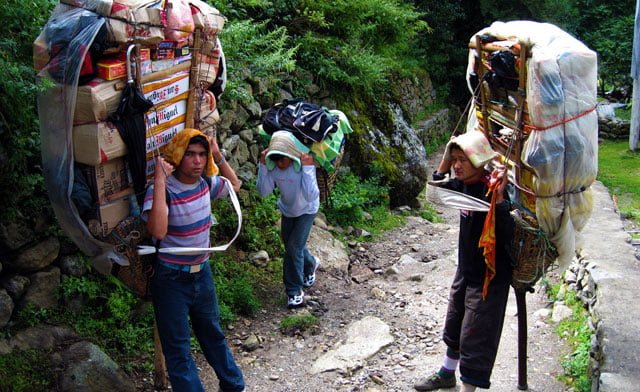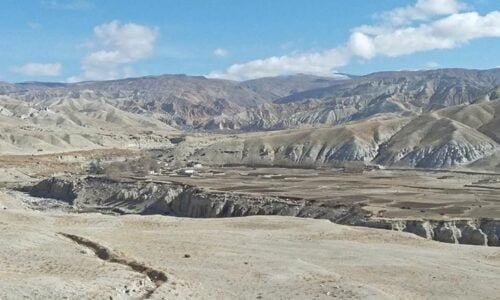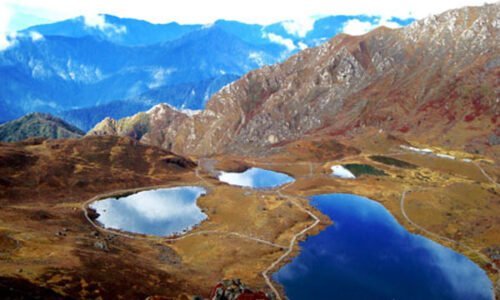Trekking Tips for Beginners in Nepal
23 May 2023 8 min to read
Outdoor Himalayan Treks brings you an important article on ‘Trekking Tips for Beginners in Nepal,’ offering essential guidelines to ensure an enjoyable and memorable trekking experience. Nepal is a trekker’s paradise as the country has abundant trekking destinations in the vicinity of snow-capped mountains. The majestic Himalayan peaks, lush valleys, ancient trails, breathtaking landscapes, and diverse cultures of Nepal provide unparalleled opportunities for trekking enthusiasts from around the world.
Nepal boasts a myriad of trekking routes suitable to all levels of trekkers be it beginner or experienced. Some popular trekking routes are Everest Base Camp Trek, Annapurna Base Camp Trek, Ghorepani Poon Hill Trek, Langtang Valley Trek, etc. Embark on a trekking journey in Nepal and immerse yourself in the wonderful natural beauty and create unforgettable memories.
As stated earlier, Nepal has trekking routes for all levels of trekkers. If you are a beginner trekker, it’s important to consider several factors to ensure a safe and enjoyable experience. Beginners should have a sound knowledge of trekking and here are some trekking tips for beginners in Nepal:
Select the short and easy treks
- Choose the trek route that fits your skill level.
- Select the trek route that fits your fitness level and interest.
- Begin with easy trek routes that can be easily achievable.
- If possible begin with short days trek.
- Have a backup plan in case of unexpected changes or weather conditions.
- Some short treks in Nepal are Annapurna Region Short Treks, Everest Region Short Treks, Langtang Region Short Treks, or Kathmandu Valley Day hikes, etc.

Select the best seasons
- Spring season (Mar-May) is the best season to trek as the weather is stable, the sky is clear with good visibility, and flower blossoms.
- Autumn season (Sep-Nov) is the second-best season to trek. The weather is stable with a clear sky and clear visibility.
- For beginners, peak seasons are best as the weather is favorable and provides the finest scenery.
- In peak seasons, the trek route is crowded and they also got to meet several fellow trekkers.
- The trekking trail is comfortable to walk during the spring and autumn seasons.
Physical & Mental Fitness
- Beginner trekkers should be both physically and mentally fit.
- Trek in Nepal requires 5-7 hours of daily walking. Thus, trekkers should be physically fit and mentally prepared.
- Prepare in advance and have a good level of physical fitness.
- For mental fitness, maintain a positive mindset, stay motivated, and manage stress.
- Physical and mental fitness contribute to your overall well-being during a trek.
Physical Training
- Physical Training is the first step for a successful trek.
- Participate in physical training in advance.
- Participate in strength training and cardio exercises under physical training.
- Strength training helps to build muscles which makes it easy to carry a backpack during the trek.
- Engage in cardio exercises like running, swimming, cycling, etc. for developing cardiovascular health and strength.
- Enroll in specific workouts such as stair climbs, and training with a mask on to simulate high-altitude conditions.
- Go for short hikes, if possible at higher elevations carrying a backpack that further helps with altitude acclimatization during trekking.
Consult with a doctor
- Doctor consultation is very important.
- Take necessary health check-ups if required.
- Follow the doctor’s instructions seriously.
- Carry essential prescribed medicines.
Travel Insurance
- An important safety tool that is very helpful for your trek.
- Consider getting insurance from a reputed company.
- Make sure travel insurance covers all emergencies (evacuations, medical), high altitudes, flight cancellations, loss of belongings, etc.
Inform your families and friends
- Inform your close family and friends before you embark on your treks in Nepal.
- Provide your detailed information such as your address, contact number, trek duration, and your availability.
- Also, provide the trekking agency and guide contact (in case of emergency).
Book with a reliable trekking agency
- While trekking in Nepal, the prime task is to book with a reliable trekking agency.
- Research and check the trekking agency’s profile thoroughly before booking.
- Make sure the trekking agency meets your requirements (guide, porter, accommodation, permits, transportation, itinerary, trek route, trek cost)
- Book with a trekking agency only after finalizing your requirements.
Use guides and Porter service
- Guide and Porter are the saviors in the mountains, especially if you are a beginner.
- Hire a licensed Guide and Porter who has years of experience
- Strictly follow the guide’s instructions.
- Stick to the same trek route.
- Inform the guide if any problem arises or have to go somewhere.
- Make sure your backpack weight limit is 8-10 kg.

Obtain necessary permits
- Make sure you obtain all necessary permits before you go on the trek.
- Provide all necessary details and photos to the trekking agency to obtain trekking permits.
- Carefully follow the rules and guidelines of the trek region.
- Keep the permits safe as it is essential to keep a record of your entry and exit during the trek.
![Trekking tips for beginners in nepal 3 A comprehensive Guide to permits for trekking in Everest region [Fees Included 2021]](https://outdoorhimalayan.com/wp-content/uploads/2021/11/Sagarmatha-NP-permit-1.jpg)
Altitude Acclimatization
- Trekkers need to take an altitude acclimatization rest.
- Altitude Acclimatization helps to adapt to the surroundings and prevent altitude sickness.
- As a beginner, strictly take acclimatization rest to ensure safety.
- Don’t get hurry to complete the trek and shorten the trek days.
- Give time for your body to adjust properly and only then continue the trek.
- Listen to your body for any signs of altitude-related health issues and immediately inform the guide if necessary.
- Stay hydrated to prevent altitude sickness.
- Avoid alcohol and smoking to prevent altitude sickness.
Local Culture and Manners
- Nepalese are very religious and cultural.
- Local culture is vibrant and unique and be prepared to experience it.
- Be respectful and mindful of cultural differences.
- Research properly about the culture before you head to your trek.
- Be mindful to wear proper dress code and not to have physical touch without permission.
- Request for permission before taking photographs of people or religious sites
- Learn a few common Nepali words like Namaste to greet and interact with the locals.
- Behave gently and experience the warm hospitality of the locals.
- Strictly follow local guidelines and practices.
Weather Conditions
- Weather conditions in the mountains are unpredictable, especially at higher altitudes.
- Despite the peak seasons, weather conditions may vary and be uncertain.
- Carefully check the weather conditions and have a backup plan during the trek for your ease.
Start Trek Early
- Start the trek early as possible to complete the trek before darkness.
- As a beginner, don’t trek more than 4-6 hours a day depending on the trek route.
- Take a 5-10 minute rest every hour.
- Start early, walk slowly, rest, and relax (continue the process).
- Don’t push yourself hard.
Eating and Drinking Habits
- Eat healthy and hygienic food.
- Drink a filter or boiled water.
- Don’t eat food and drink water from unfamiliar sources.
- During the trek, if possible try to avoid meat and eat vegetarian meals for good digestion.
- Carry a water bottle to refill water and water purification kits to ensure safe drinking water.
- Drink a lot of water to stay hydrated and prevent altitude sickness.
- Take a sip of water frequently to stay hydrated.
- Bring some light snacks, chocolate bars, and an energy drink mix to munch during the trek.
Safety and Emergency Preparation
- Strictly follow the guide’s instructions.
- Stay on the designated trail.
- Inform the guide if you have to go to the toilet and don’t go far.
- Inform the guide or ask for guidelines if any concern arises.
- Descend quickly but slowly if you feel the symptom of altitude sickness.
- Use trekking poles for safety.
- Wear sunglasses for eye protection.
- Apply sunscreen for skin protection.
- Don’t push yourself hard to complete the trek.
- Be cautious while walking on difficult sections of the trail.
- Wear proper clothes and shoes for a comfortable trekking experience.
- Carry necessary medicine for safety and any emergency.
- Stay hydrated and eat healthy food.
- Carry a proper first aid kit, a map, and emergency contact numbers.

Packing Essentials
- Foods (Light snacks, chocolate bars, energy bars), and Energy Drink Mix
- Clothes (Lightweight warm clothes, jacket, thermals, trekking pants, trousers, raincoat, balaclava, gaiters, inner garments, socks, gloves, hanky, towel)
- Shoes (a durable and comfortable trekking boot, sandal, and normal close or sports shoes)
- Accessories (Hats, sunglasses, water bottle, torch, water purifying kit/tablet, umbrella, sewing kit, pocket knife)
- Important travel documents (Visa, Passport, Travel Insurance, PP-size photos, and copies of travel documents for safety.)
- Essential Electronic devices (Camera, Phone, Universal Adapter, Charger, Power Bank, Extra Batteries)
- Personal Kit ( Medicine, Sunscreen, Lotion, Wet Wipes, Tissues, Sanitary Napkins for ladies, Soap, Sachet, Toothbrush, Toothpaste, Comb, etc.)
- Equipment (A sleeping bag, trekking poles, a map, a duffel bag, a backpack)
Responsible Trekking
- Waste management and disposal of waste properly.
- Make sure to carry reusable bags for waste management.
- Don’t litter everywhere and try to keep the environment clean.
- No closeness with wild animals.
- Don’t touch or pick any wild flora.
- Respect local communities.
We kindly request all travelers to strictly follow trekking tips for beginners in Nepal for a safe and memorable trip. Go through 10 Easy Beginner Treks in Nepal, if you are planning for and choose the desired destination that fits you. Feel free to contact us for further queries.





